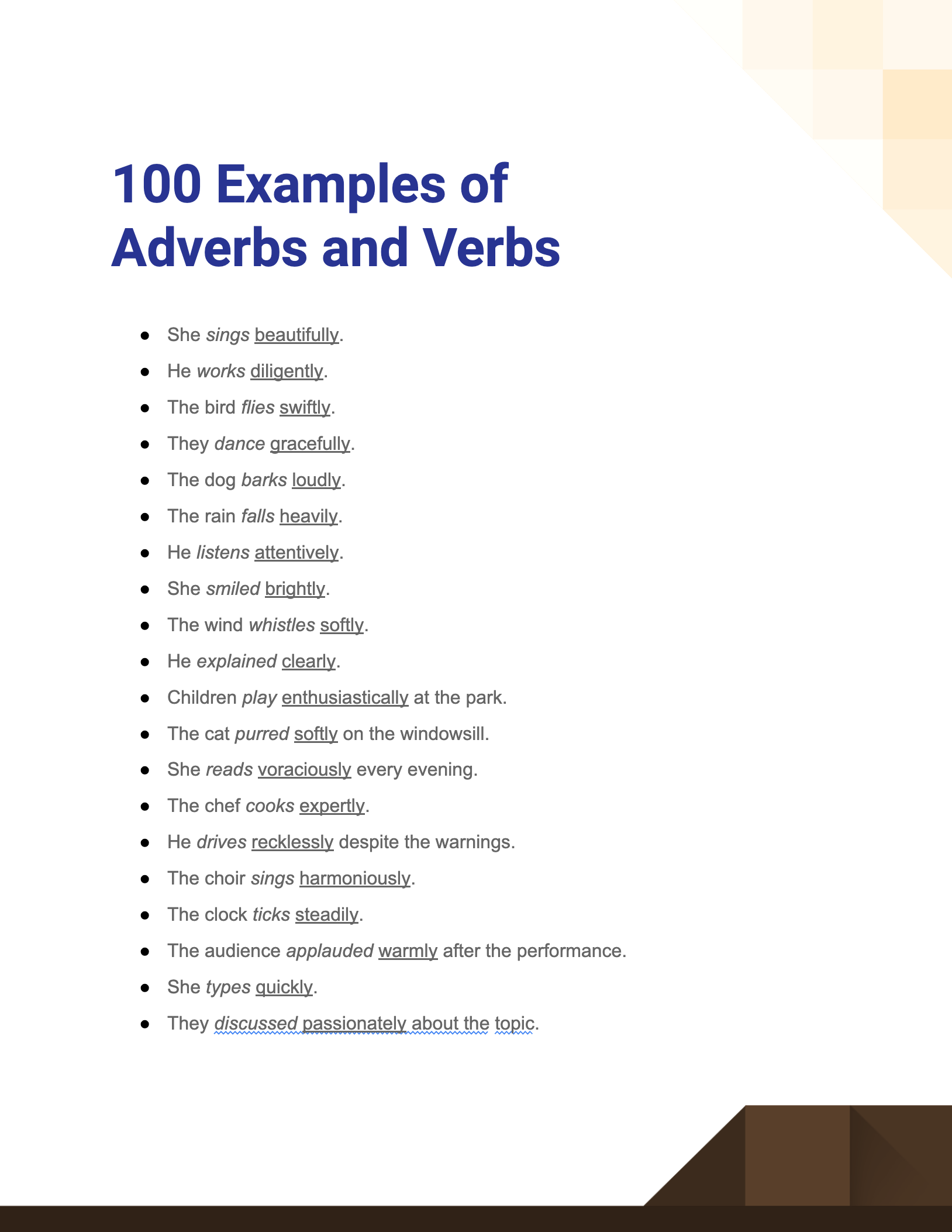99+ Adverbs and Verbs Examples
Unlock the vibrant dance between adverbs and verbs with our comprehensive guide! As the backbone of expressive writing, verbs denote action, while adverbs gracefully refine their intensity, manner, or frequency. By intertwining these linguistic elements, you can craft sentences that truly resonate. Whether you’re a grammar novice or looking to refresh your skills, dive into our curated adverb examples, insightful usage techniques, and expert tips to elevate your prose. Embrace the dynamism of adverbs and verbs today!
What are Adverbs and Verbs? – Definition
- Verbs are action words in a sentence that describe what the subject is doing. They denote actions, events, or states of being. For instance, in the sentence “She runs daily,” “runs” is the verb showcasing the action.
- Adverbs are the modifiers of verbs, adjectives, or other adverbs. They provide additional information about how, where, when, or to what extent the action is performed. For example, in the sentence “He speaks loudly,” “loudly” describes how the action of speaking is done.
What is an example of Adverb and Verb?
Consider the sentence: “She sings beautifully.”
- Here, “sings” is the verb, denoting the action of the subject.
- “Beautifully” is the adverb, elaborating on the manner in which the action (singing) is performed. It tells us that she doesn’t just sing; she sings in a beautiful manner.
100 Examples of Adverbs and Verbs

Discover the Dynamic Interplay of Adverbs and Verbs! Adverbs and verbs together bring nuance and depth to your sentences, making them lively and expressive. These linguistic pairings offer insight into the action and its quality. Explore our curated list of 100 exemplary sentences (adverbs mentioned in bold, Verbs mentioned in Italic) to master the intricate dance between adverbs and verbs, refining your linguistic flair.
- She sings beautifully.
- He works diligently.
- The bird flies swiftly.
- They dance gracefully.
- The dog barks loudly.
- The rain falls heavily.
- He listens attentively.
- She smiled brightly.
- The wind whistles softly.
- He explained clearly.
- Children play enthusiastically at the park.
- The cat purred softly on the windowsill.
- She reads voraciously every evening.
- The chef cooks expertly.
- He drives recklessly despite the warnings.
- The choir sings harmoniously.
- The clock ticks steadily.
- The audience applauded warmly after the performance.
- She types quickly.
- They discussed passionately about the topic.
- The fire burns brightly in the fireplace.
- The artist paints meticulously.
- He jumps highly during the game.
- The wind howled ferociously last night.
- She spoke gently to the upset child.
- The horse galloped fiercely across the meadow.
- She dresses elegantly for every occasion.
- The river flows silently through the forest.
- The athlete trains rigorously.
- Birds chirp melodiously in the morning.
- The writer thinks deeply about the storyline.
- He waits patiently for his turn.
- The machine operates smoothly.
- The actor performed brilliantly on stage.
- He whispered secretly to his friend.
- The computer runs efficiently.
- They study consistently for exams.
- The gardener plants lovingly.
- The baby cried loudly when hungry.
- She answered correctly to all questions.
- The guitarist strummed gently during the soft melody.
- The sun shines brightly every summer morning.
- The teacher explains thoroughly to ensure understanding.
- The lion roared mightily in the jungle.
- He stares intently at the painting.
- The marathon runner jogs steadily for hours.
- The detective searched meticulously for clues.
- The poet writes eloquently about love.
- The builder constructed sturdily ensuring durability.
- The student thinks critically during the exam.
- The wind rustles gently through the trees.
- She decorates tastefully for every event.
- The eagle soars majestically above the mountains.
- The mechanic works skillfully under the car.
- The pianist plays melodically during the recital.
- The snake slithered silently through the grass.
- The actor recited flawlessly during the monologue.
- The baker mixes thoroughly to achieve a smooth batter.
- He negotiated tactfully during the meeting.
- The car accelerated rapidly on the open road.
- She sipped gingerly from the hot cup of tea.
- The musician practiced relentlessly for the big concert.
- He dreams vividly every night.
- The children screamed excitedly on the roller coaster.
- The dog wagged its tail happily.
- The photographer focused carefully before taking the shot.
- The waves crashed violently against the rocks.
- He listened intently to the mysterious sounds of the night.
- She danced freely under the starry sky.
- The athletes competed fiercely for the gold medal.
- The writer scribbled furiously as ideas flowed.
- The bee buzzed incessantly around the flowers.
- The tailor stitched neatly ensuring a perfect fit.
- She hugged tightly out of sheer joy.
- The potter molded the clay delicately.
- He laughed heartily at the amusing anecdote.
- The clock chimed eerily at midnight.
- The child giggled innocently at the clown’s antics.
- The chef chopped precisely ensuring even slices.
- The scientist observed keenly noting all changes.
- The writer writes passionately about social issues.
- The detective investigates thoroughly to solve the case.
- The gymnast performs gracefully on the balance beam.
- The comedian tells jokes hilariously.
- She waved enthusiastically to her friend.
- The children laughed uproariously at the funny clown.
- The chef cooks creatively with unique ingredients.
- He sings soulfully at the local café.
- The surfer rides waves expertly.
- The artist paints vividly with bold colors.
- The sun sets beautifully over the horizon.
- The car drives smoothly on the highway.
- She reads quietly in the cozy library.
- The actor performs emotionally in the dramatic scene.
- He swims freestyle in the pool.
- The rocket blasted off majestically into space.
- The guitarist strums softly during the ballad.
- The bird sings sweetly in the morning.
- She whispers gently to her baby.
- The mountain climber ascends daringly to the summit.
How to Use Adverbs and Verbs?
Adverbs and verbs are fundamental components of English grammar that work together to provide depth and detail to your sentences. Here’s a comprehensive guide on how to effectively use adverbs and verbs in your writing:
1. Identify the Verb:
- Start by identifying the main verb in your sentence. The verb is the action word that tells you what’s happening.
- Example: In the sentence “She sings beautifully,” “sings” is the verb.
2. Determine the Adverb’s Purpose:
- Adverbs provide additional information about the verb. They can describe how, when, where, or to what extent the action is performed.
- Example: In “She sings beautifully,” “beautifully” describes how she sings.
3. Choose the Right Adverb:
- Select an adverb that precisely conveys the intended meaning. Consider the context of your sentence.
- Example: “He runs quickly” vs. “He runs slowly.”
4. Position the Adverb:
- Adverbs can appear in different parts of the sentence. Common positions include:
- Before the verb: “She quickly runs.”
- After the verb: “She runs quickly.”
- At the beginning or end of the sentence: “Quickly, she runs” or “She runs quickly, too.”
- Adjust the placement for emphasis and clarity.
5. Avoid Redundancy:
- Be cautious not to use an adverb that repeats the meaning of the verb. This can make your writing redundant.
- Example: Instead of “He whispered quietly,” you can simply say, “He whispered.”
Tips for Using Adverb and Verb
1. Show, Don’t Tell:
- Use adverbs and verbs to paint vivid pictures in your reader’s mind. Instead of saying “She walked slowly,” describe the scene: “She tiptoed through the room.”
2. Vary Your Adverbs:
- Repeatedly using the same adverb can become monotonous. Experiment with synonyms to keep your writing engaging.
- Example: Instead of “She smiled happily,” try “She smiled joyfully.”
3. Context Matters:
- Choose adverbs that align with the context of your sentence. Ensure they make sense in the given situation.
- Example: “He laughed nervously” would be appropriate in a tense situation but not during a comedy show.
4. Use Adverbs Sparingly:
- While adverbs can enhance your writing, overusing them can lead to cluttered and weak sentences. Use them when they genuinely add value.
- Example: “She quickly and elegantly danced” might be better as “She danced gracefully.”
5. Revise and Edit:
- After writing, review your sentences. Look for opportunities to refine your use of adverbs and verbs for greater clarity and impact.
6. Read Aloud:
- Reading your writing aloud can help you identify where adverbs and verbs can improve the flow and rhythm of your prose.
By mastering the art of using adverbs and verbs effectively, you can create writing that is not only grammatically correct but also engaging, descriptive, and impactful.



